vGuru Software:
We briefly touched on ABIT’s vGuru software earlier; it comes included in the ABIT RX600 Pro-Guru’s bundle. On boot in to windows after the software is installed, a small program flashes up to inform you what mode the video card is running in. When the green LED is lit, a green splash screen shows that the video card is running in Normal mode, in the same vain, when the red LED is lit, a splash screen shows that the video card is running in XTurbo mode; we don’t think it will surprise you when we tell you that the splash screen is red this time.
On our test bench, this isn’t a great deal of use to us because we can see the bright green or red light, which tells us which mode the video card is running in. However, if you are thinking of putting this video card inside a case, it may come in useful there. It could also become quite annoying – this reviewer in particular doesn\'t appreciate unneeded start up applications.
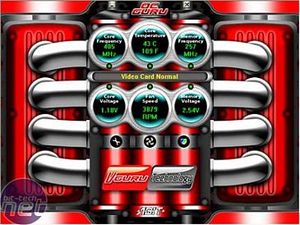
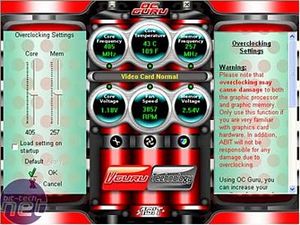 When OCGuru is opened from the start menu, you are greeted with a rather aggressive looking program – it looks like it means business for certain. The dials are clickable and go through to various screens.
When OCGuru is opened from the start menu, you are greeted with a rather aggressive looking program – it looks like it means business for certain. The dials are clickable and go through to various screens.
On clicking on either of the dials labelled “Core Frequency” or “Memory Frequency”, you are greeted with the Overclocking Settings screen that allows you to adjust both core and memory frequencies. You can also force a certain clock speed at system start up.
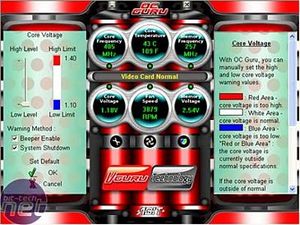
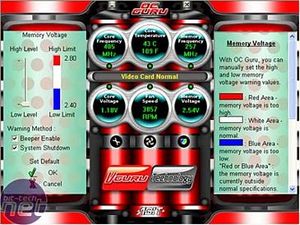 The next screens that we looked at were the core and memory voltage adjustment screens – something that is a completely new feature unique to ABIT at this time. OCGuru allows you to adjust the voltages for both the core and memory, within safe limits, of course. This isn’t quite the same as volt modding the video card with 18-turn cermet potentiometers, but it’s a first so far as offering an element of control over how much voltage you are supplying to both the core and memory without being forced to get the screwdriver and soldering iron out. This should help with overclocking the video card further – it would be great to see this kind of functionality on ABIT’s high-end video cards, and we wouldn’t be surprised if this did come about sooner or later.
The next screens that we looked at were the core and memory voltage adjustment screens – something that is a completely new feature unique to ABIT at this time. OCGuru allows you to adjust the voltages for both the core and memory, within safe limits, of course. This isn’t quite the same as volt modding the video card with 18-turn cermet potentiometers, but it’s a first so far as offering an element of control over how much voltage you are supplying to both the core and memory without being forced to get the screwdriver and soldering iron out. This should help with overclocking the video card further – it would be great to see this kind of functionality on ABIT’s high-end video cards, and we wouldn’t be surprised if this did come about sooner or later.
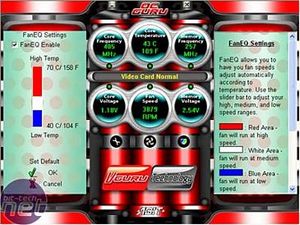
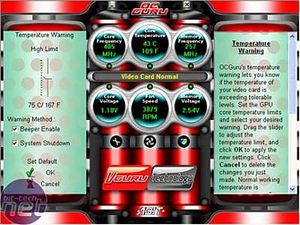 FanEQ allows the user to enable temperature-controlled fan speed – we did not notice the fan spinning up during our testing at both stock and overclocked settings. Having said that, our test lab has good ventilation and remains at a constant 23°C – this is quite low for a typical case temperature. Finally, there is the ability to set alerts when the GPU temperature exceeds a certain value – the software will alert you, shut down the system, and even email you when the temperature exceed what the user has specified.
FanEQ allows the user to enable temperature-controlled fan speed – we did not notice the fan spinning up during our testing at both stock and overclocked settings. Having said that, our test lab has good ventilation and remains at a constant 23°C – this is quite low for a typical case temperature. Finally, there is the ability to set alerts when the GPU temperature exceeds a certain value – the software will alert you, shut down the system, and even email you when the temperature exceed what the user has specified.
On the whole, vGuru brings some interesting new options to the table for the video card enthusiast – we can’t wait to see this kind of functionality implemented in to ABIT’s high-end video cards.
Please be aware that the way we test our video cards is not a like-for-like comparison, and it is not meant to be. The current state of the 3D world, where Independent Hardware Vendors no longer render things in a similar fashion, dictates that even an apples-to-apples comparison is no longer a true like-for-like comparison. We decided to concentrate on finding the “Best Playable” settings - this means that we’re finding the best possible gaming experience delivered on each different configuration. There are no time demos used in our evaluations - we’re focusing on the real-world gaming experience, which is, ultimately what should determine your next graphics card’s purchase.
System Setup:
AMD Athlon 64 FX-55 (operating at 1600MHz - 8x200); DFI LANParty NF4 SLI-DR (NVIDIA NForce4 SLI); 2 x 256MB Kingston HyperX PC3200 (operating in dual channel with 2.5-3-3-7 timings); Western Digital 200GB Caviar SATA 150 Hard disk drive; Windows XP Professional Service Pack 2; DirectX 9.0c; NVIDIA standalone nForce4 chipset drivers, version 6.39;
Graphics Cards:
The video card drivers were left at their default settings with the exception of Vsync, which was disabled in all cases.
We briefly touched on ABIT’s vGuru software earlier; it comes included in the ABIT RX600 Pro-Guru’s bundle. On boot in to windows after the software is installed, a small program flashes up to inform you what mode the video card is running in. When the green LED is lit, a green splash screen shows that the video card is running in Normal mode, in the same vain, when the red LED is lit, a splash screen shows that the video card is running in XTurbo mode; we don’t think it will surprise you when we tell you that the splash screen is red this time.
On our test bench, this isn’t a great deal of use to us because we can see the bright green or red light, which tells us which mode the video card is running in. However, if you are thinking of putting this video card inside a case, it may come in useful there. It could also become quite annoying – this reviewer in particular doesn\'t appreciate unneeded start up applications.


On clicking on either of the dials labelled “Core Frequency” or “Memory Frequency”, you are greeted with the Overclocking Settings screen that allows you to adjust both core and memory frequencies. You can also force a certain clock speed at system start up.




On the whole, vGuru brings some interesting new options to the table for the video card enthusiast – we can’t wait to see this kind of functionality implemented in to ABIT’s high-end video cards.
_____________________________
How We Tested:Please be aware that the way we test our video cards is not a like-for-like comparison, and it is not meant to be. The current state of the 3D world, where Independent Hardware Vendors no longer render things in a similar fashion, dictates that even an apples-to-apples comparison is no longer a true like-for-like comparison. We decided to concentrate on finding the “Best Playable” settings - this means that we’re finding the best possible gaming experience delivered on each different configuration. There are no time demos used in our evaluations - we’re focusing on the real-world gaming experience, which is, ultimately what should determine your next graphics card’s purchase.
System Setup:
AMD Athlon 64 FX-55 (operating at 1600MHz - 8x200); DFI LANParty NF4 SLI-DR (NVIDIA NForce4 SLI); 2 x 256MB Kingston HyperX PC3200 (operating in dual channel with 2.5-3-3-7 timings); Western Digital 200GB Caviar SATA 150 Hard disk drive; Windows XP Professional Service Pack 2; DirectX 9.0c; NVIDIA standalone nForce4 chipset drivers, version 6.39;
Graphics Cards:
- ABIT RX600 Pro-Guru 256MB - operating at both its default clock speeds of 400/257MHz and its enhanced clock speeds of 500/257MHz using Catalyst 5.2 with Catalyst Control Center.
- NVIDIA GeForce 6600 128MB - we have clocked down our reference GeForce 6600GT to represent a 128MB GeForce 6600. It is running at clock speeds of 300/550MHz using ForceWare 67.66 beta, available from NZone. These clock speeds seem to represent a typical retail GeForce 6600.
- GeCube Radeon X300 128MB - operating at its default clock speeds of 325/400MHz using Catalyst 5.2 with Catalyst Control Center.
- NVIDIA GeForce 6200 TurboCache 32MB/128MB - operating at its default clock speeds of 350/700MHz using beta ForceWare 70.20. Unfortunately, these drivers are not publicly available from an official source at the moment.
The video card drivers were left at their default settings with the exception of Vsync, which was disabled in all cases.

MSI MPG Velox 100R Chassis Review
October 14 2021 | 15:04







Want to comment? Please log in.